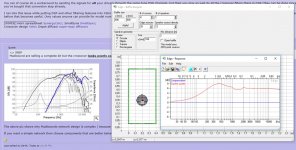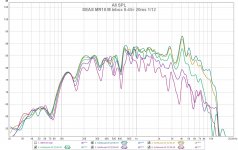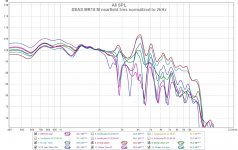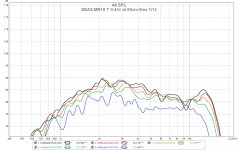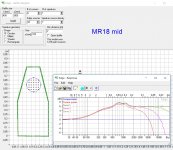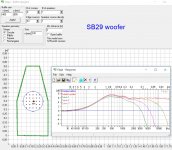Has anybody have a good crossover design for this driver as part of a three way ?
Madisound are selling a complete kit but the crossover looks overly complex to me.That kit also uses two 8 ohm woofers in parallel and I was trying to avoid low impedance.
https://www.google.com.au/url?sa=t&...nge-coaxial/&usg=AOvVaw38kLqlXLdPqT88FOd8PBOH
Madisound are selling a complete kit but the crossover looks overly complex to me.That kit also uses two 8 ohm woofers in parallel and I was trying to avoid low impedance.
https://www.google.com.au/url?sa=t&...nge-coaxial/&usg=AOvVaw38kLqlXLdPqT88FOd8PBOH
I just found a kit made by Udo Wohlgemuth and it is sold by intertechnik.de
The evaluation report or creation progress also with a schemtaic of the used crossover topology can be found here: Der Lautsprecher Club - April 2015 - Lautsprecherbau-Magazin 2015 | Lautsprecherbau - Lautsprecher selber bauen
Sorry the report is in german but the pictures are somehow self explaining.
Praobably the informations are helping 🙂
The evaluation report or creation progress also with a schemtaic of the used crossover topology can be found here: Der Lautsprecher Club - April 2015 - Lautsprecherbau-Magazin 2015 | Lautsprecherbau - Lautsprecher selber bauen
Sorry the report is in german but the pictures are somehow self explaining.
Praobably the informations are helping 🙂
That's because the coaxial is 89dB/1m sensitivity. Without attenuating the coax (which would require even more XO complexity), for full baffle step the woofer needs to be 95dB/1m sensitive. The solution is one huge (probably 15 or 18") woofer, or two smaller woofers. Most amplifiers will have no problem driving it - it's a typical 4 ohm design. Of course, there is no reason you can't "delete" the woofers and the highpass section of the coax crossover to run it "full-range". You would not have any baffle-step in the design though. Be aware also that the coax is designed as a mid so it's bass capability is limited, hence the design with dedicated woofers.That kit also uses two 8 ohm woofers in parallel and I was trying to avoid low impedance.
Pretty sure there's only one tweeter option for the H1699. The one in the middle.There are several xos available, but there are several tweeter options too.
Last edited:
Thanks for the replies.
I have a pair of Fostex FW305 12 inch woofers.
Perhaps they might be a good match ? 95db sensitivity.8 ohm.
https://www.google.com.au/url?sa=t&rct=j&q=&esrc=s&source=web&cd=1&cad=rja&uact=8&ved=0ahUKEwjKut3Au-bZAhXosFQKHV0aCZsQFggnMAA&url=https%3A%2F%2Fwww.madisoundspeakerstore.com%2Fapprox-12-woofers%2Ffostex-fw305-12-woofer%2F&usg=AOvVaw2u8p-TUNLdAhN8iFmZMj3o
I have a pair of Fostex FW305 12 inch woofers.
Perhaps they might be a good match ? 95db sensitivity.8 ohm.
https://www.google.com.au/url?sa=t&rct=j&q=&esrc=s&source=web&cd=1&cad=rja&uact=8&ved=0ahUKEwjKut3Au-bZAhXosFQKHV0aCZsQFggnMAA&url=https%3A%2F%2Fwww.madisoundspeakerstore.com%2Fapprox-12-woofers%2Ffostex-fw305-12-woofer%2F&usg=AOvVaw2u8p-TUNLdAhN8iFmZMj3o
Last edited:
The midrange in a 3-way speaker needs both high- and low-pass filters. That is why the schematics might look complex.
Nowdays one should also consider dsp-based xo between bass and mid. This has severals benefits - you don't have to take care of sensitivity matching, baffle step compensation or impedance issues. The xo must be set by measuring acoustic output at roughly 1m distance, simulation is not possible or needed. The problem is in making accurate measurements indoors!
Nowdays one should also consider dsp-based xo between bass and mid. This has severals benefits - you don't have to take care of sensitivity matching, baffle step compensation or impedance issues. The xo must be set by measuring acoustic output at roughly 1m distance, simulation is not possible or needed. The problem is in making accurate measurements indoors!
I do not understand why SEAS would go to all the trouble of manufacturing this and then not design a crossover and baffle design to suit it.
Nowdays one should also consider dsp-based xo between bass and mid. This has severals benefits - you don't have to take care of sensitivity matching, baffle step compensation or impedance issues. The xo must be set by measuring acoustic output at roughly 1m distance, simulation is not possible or needed. The problem is in making accurate measurements indoors!
I agree with everything here except the part about simulations not being possible. As an example LspCAD6 has had support for simulating loudspeakers with a mix of active (digital and/or analog) and passive crossovers for many years.
While not necessarily needed, they can be quite useful provided that the input data is of sufficient quality (your last point).
Well this is almost the same, just some xo tweaking is needed
SEAS KingRO4Y Mk II

This is a 2-way with a more robust woofer
SEAS Loki MkIII
SEAS KingRO4Y Mk II

This is a 2-way with a more robust woofer
SEAS Loki MkIII
I would prefer to stick to passive crossovers and paper cones.I really don't like the sound of those magnesium cones.
I have used digital crossovers and EQ but never managed to get decent sound.You might be able to get on axis nice and flat but how about the off axis?
I have used digital crossovers and EQ but never managed to get decent sound.You might be able to get on axis nice and flat but how about the off axis?
I would prefer to stick to passive crossovers and paper cones.I really don't like the sound of those magnesium cones.
I have used digital crossovers and EQ but never managed to get decent sound.You might be able to get on axis nice and flat but how about the off axis?
MR is a nice driver yes, even though I have never heard it!
Designing a multi-way loudspeaker with dsp is basically just as challenging as passive and directivity should be remembered as well - dsp can't change it!
This is a nice tutorial about setting up dsp multiway, don't get confused because it is dipole. Same principles work for monopoles too. The point is to work with measured acoustic responses and timing!
http://www.hifizine.com/2010/12/prototyping-4-way-open-baffle-speaker-with-the-minidsp-2x4/
Please study also parts 2 and 3 mentioned in the txt! This helped me a lot to progress systematically with my AINOgradients
Last edited:
This is MR18 responses from datasheet

and this C18 - not so different? MR is 3dB louder and smoother!

and this C18 - not so different? MR is 3dB louder and smoother!
An externally hosted image should be here but it was not working when we last tested it.
I agree with everything here except the part about simulations not being possible. As an example LspCAD6 has had support for simulating loudspeakers with a mix of active (digital and/or analog) and passive crossovers for many years.
True, but that turns out to not be as straightforward as it might seem. DSP crossovers use data converters and memory registers which causes them to have inherent time delays (on the order of several milliseconds) for signals passing through them, even before any filtering is programmed into them. And guess what parameter is almost impossible to find in DSP crossover devices' data sheets! Yup. that inherent delay!
So you may need to find (or more likely, measure) that first before you can make any valid simulation. Still, several milliseconds of delay difference (about 24 inches of acoustic travel) is pretty hard to tweak out using just driver offsets or passive components.
You can of course do a workaround by sending the signals for all your drivers through the same type DSP channels, but then you may as well do all the crossover filters there in DSP (they can be done more accurately than passive) since you've bought that conversion step already.
I ran into this issue while putting DSP and other filtering features into XSim (beta is at http://libinst.com/Xsim/BetaTest/XSim3DSetup.exe). I have a control placed for selecting the "inherent delay" but need to gather values to put in a table before that becomes useful. (Any values anyone can provide for model numbers would be appreciated!)
<> SNIP
Madisound are selling a complete kit but the crossover looks overly complex to me.

The above pic shows why Madisounds network design is complex ( because it needs to be to hammer that mess into something linear )!
If you want a simple network then choose components that are better behaved within their pass bands ( & stop bands ).
🙂
Last edited:
to bwaslo - yes, many people forget that and keep hitting their head against the wall. Using the same dsp board to high-pass the passive M/T makes it much easier to control delays! This is what I am planning to do next.
^baffle step of a rather wide cabinet will help to straighten the mid's response!
400mm (16") here
^baffle step of a rather wide cabinet will help to straighten the mid's response!
400mm (16") here
Attachments
Last edited:

The above pic shows why Madisounds network design is complex ( because it needs to be to hammer that mess into something linear )!
If you want a simple network then choose components that are better behaved within their pass bands ( & stop bands ).
🙂
Yes it looks challenging.The big peak at around 4-5k looks especially troublesome.
Perhaps the first approach would be to try less steep crossover slopes and just see how it sounds.A bit of uneven response in these point source type drivers may not be as much of an issue as in more conventional types.I suspect the older Tannoy dual concentrics do not measure perfectly but that does not stop them sounding very good.
So, now I have a pair of MR18 in my hands! My plan is to make a semiactive 3-way using it and SB29NRX woofers, floorstanding sealed box and minidsp PowerICE-125 amplifier-dsp boards.
Here are my first measurements of MR18 in a 7 liter closed box, baffle 19x28cm. We can see from nearfield measurements, that the peak at 5kHz is NOT exactly cone resonance, but more like a cavity resonance based on geometry. Look how nearfield off-axis measurement changes in normalized graph!
Looks like the tweeter shows directivity only in low treble and is exceptionally non-directive up to 10kHz. Crossing around 2,5 - 3,5kHz should be ok. Peak attenuation at 5kHz is perhaps not needed at all. Lower xo around 400Hz LR2 should be easy too.
Here are my first measurements of MR18 in a 7 liter closed box, baffle 19x28cm. We can see from nearfield measurements, that the peak at 5kHz is NOT exactly cone resonance, but more like a cavity resonance based on geometry. Look how nearfield off-axis measurement changes in normalized graph!
Looks like the tweeter shows directivity only in low treble and is exceptionally non-directive up to 10kHz. Crossing around 2,5 - 3,5kHz should be ok. Peak attenuation at 5kHz is perhaps not needed at all. Lower xo around 400Hz LR2 should be easy too.
Attachments
MR18 3way by Juhazi
Here some Edge simulations and a 3d sketch of the box. Top part of the baffle will be tilted and I will add diamond cuts to edges following the style of Avalon speakers. Box material will be MDF with birch veneer, tinted and waxed. These speakers will be a joint project with my older son.
Here some Edge simulations and a 3d sketch of the box. Top part of the baffle will be tilted and I will add diamond cuts to edges following the style of Avalon speakers. Box material will be MDF with birch veneer, tinted and waxed. These speakers will be a joint project with my older son.
Attachments
Editing just got timed out...
Two kits to steal ideas from:
Seas CX871 Coaxial 3-Way Speaker Kit by Peter Noerbaek - Pair
Der Lautsprecher Club - April 2015 - Lautsprecherbau-Magazin 2015 | Lautsprecherbau - Lautsprecher selber bauen
Two kits to steal ideas from:
Seas CX871 Coaxial 3-Way Speaker Kit by Peter Noerbaek - Pair
Der Lautsprecher Club - April 2015 - Lautsprecherbau-Magazin 2015 | Lautsprecherbau - Lautsprecher selber bauen
- Status
- Not open for further replies.
- Home
- Loudspeakers
- Multi-Way
- Seas 7 inch coaxial midrange crossover?
